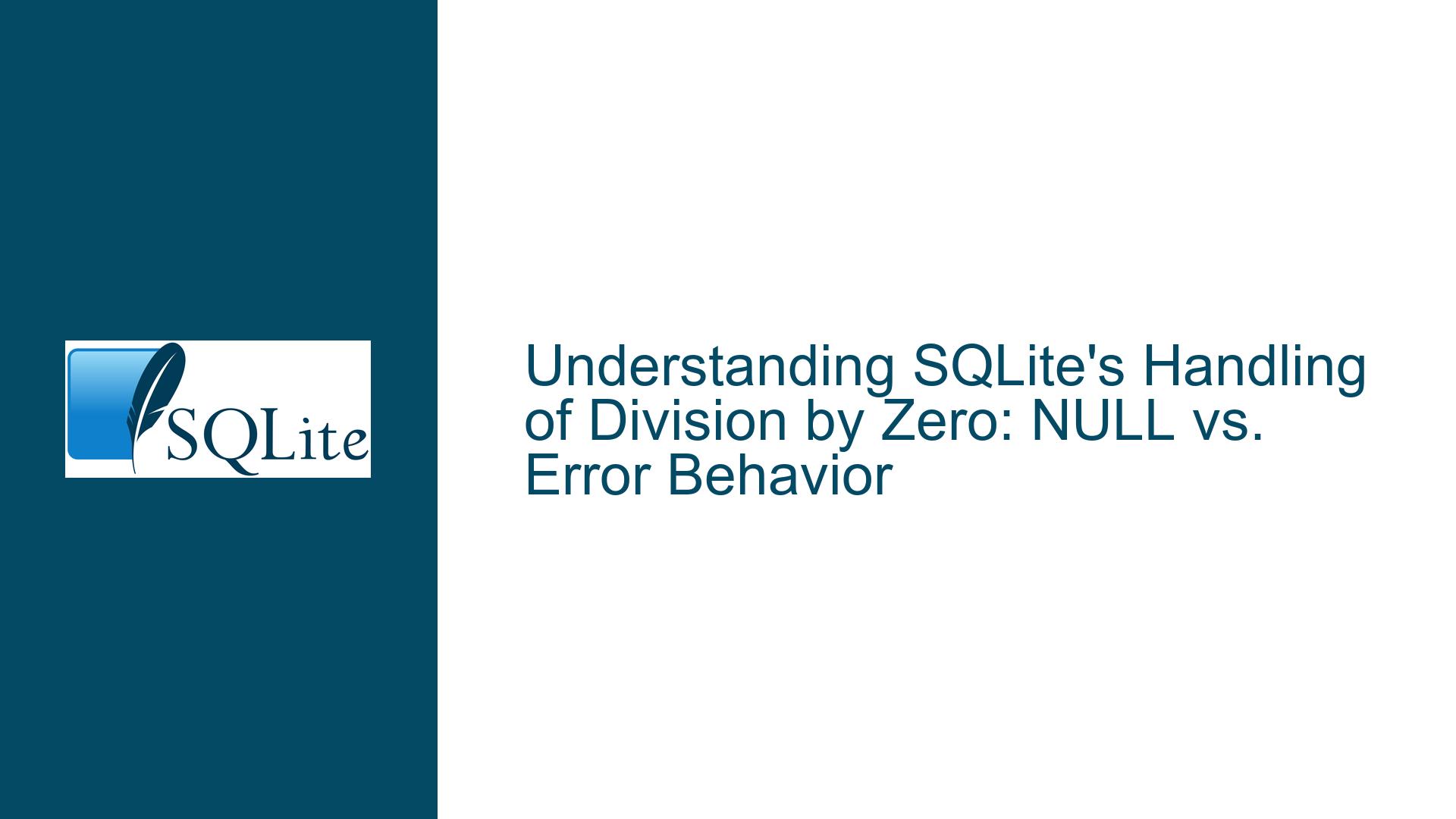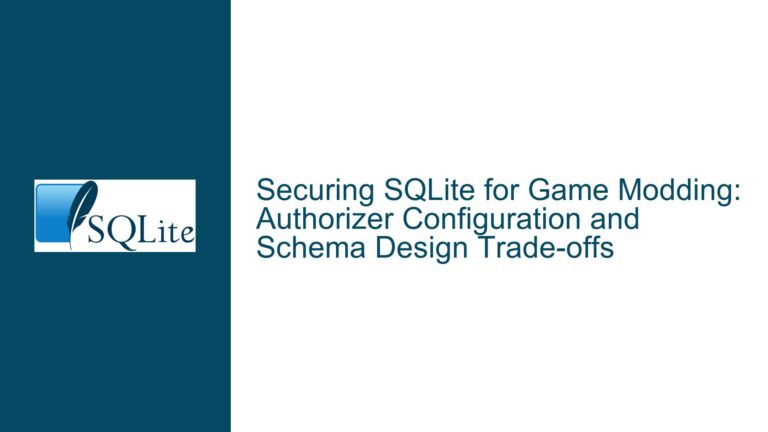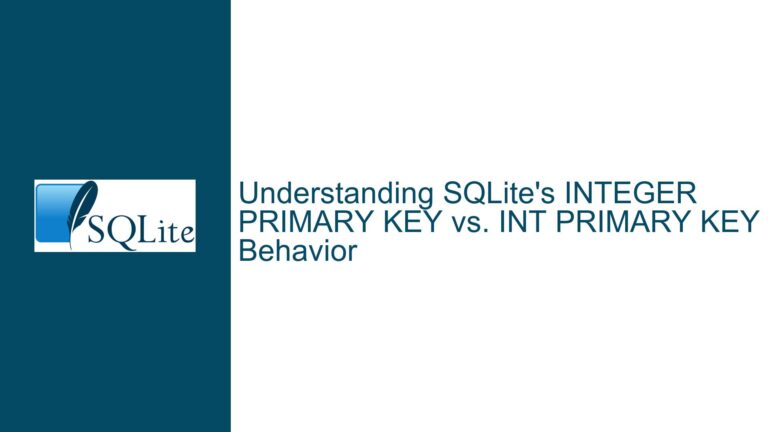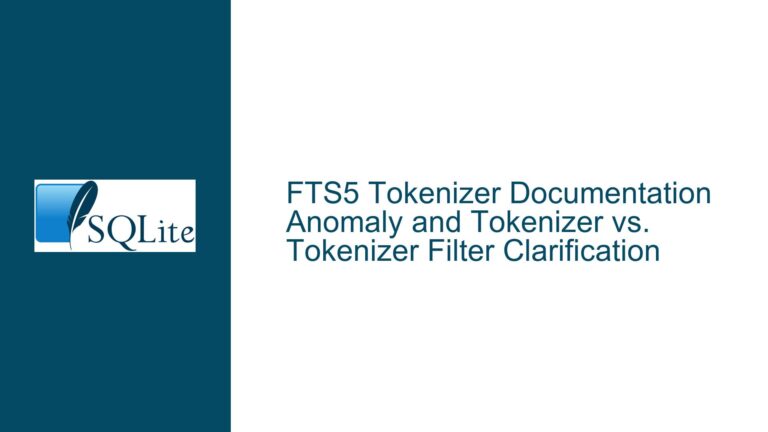SQLite’s Handling of Division by Zero: NULL vs. Error Behavior
Issue Overview: SQLite’s Decision to Return NULL on Division by Zero
In SQLite, when a division by zero occurs, the result is NULL rather than an error. This behavior is intentional and differs from some other database management systems (DBMS) like PostgreSQL, which may raise an error in such cases. The rationale behind SQLite’s approach is rooted in practicality, performance considerations, and the semantic meaning of NULL in SQL. However, this design choice has sparked discussions about its implications, particularly in scenarios where distinguishing between 1/0 and 0/0 is critical.
The core issue revolves around understanding why SQLite opts for NULL instead of raising an error, how this aligns with the broader SQL standard, and what implications this has for developers. Additionally, the discussion touches on the behavior of floating-point arithmetic in other systems, such as IEEE 754, which produces Infinity or NaN (Not a Number) for division by zero, and how SQLite handles these values.
SQLite’s approach is not arbitrary but is influenced by its lightweight nature and focus on performance. For instance, in a long-running query, encountering a division by zero near the end could result in the entire query failing, discarding hours of work. By returning NULL, SQLite allows the query to complete, leaving it to the developer to handle the NULL value appropriately.
However, this design choice has trade-offs. For example, it becomes challenging to differentiate between 1/0 (which is mathematically undefined) and 0/0 (which is indeterminate) since both return NULL. This lack of distinction can be problematic in certain applications, such as scientific computing or financial calculations, where understanding the nature of the error is crucial.
Possible Causes: Why SQLite Returns NULL Instead of Raising an Error
The decision to return NULL for division by zero in SQLite can be attributed to several factors, including performance considerations, alignment with SQL semantics, and the influence of floating-point arithmetic standards.
Performance Considerations
One of the primary reasons SQLite returns NULL instead of raising an error is performance. SQLite is designed to be a lightweight, embedded database engine that prioritizes efficiency. Raising an error for division by zero could significantly impact performance, especially in long-running queries. For example, if a query processes millions of rows and encounters a division by zero on the last row, raising an error would discard all the work done up to that point. By returning NULL, SQLite allows the query to complete, enabling the developer to handle the NULL value as needed.
Alignment with SQL Semantics
In SQL, NULL represents an unknown or missing value. When a division by zero occurs, the result is mathematically undefined, which aligns with the concept of NULL in SQL. By returning NULL, SQLite adheres to the semantic meaning of NULL as a representation of an undefined or unknown value. This approach is consistent with how SQL handles other undefined operations, such as concatenating NULL with a string or performing arithmetic operations involving NULL.
Influence of Floating-Point Arithmetic Standards
SQLite’s behavior is also influenced by the IEEE 754 standard for floating-point arithmetic, which defines how floating-point operations should behave. According to IEEE 754, dividing a non-zero number by zero results in Infinity, while dividing zero by zero results in NaN. SQLite, however, converts both Infinity and NaN to NULL when inserting them into the database. This conversion is likely due to the similarity in semantics between NaN and NULL—both represent undefined or unknown values. By converting these values to NULL, SQLite simplifies the handling of undefined results and avoids introducing additional types that could complicate the database schema.
Comparison with Other Systems
The behavior of SQLite contrasts with other systems, such as PostgreSQL, which raises an error for division by zero. In PostgreSQL, the error provides a clear indication that an undefined operation has occurred, allowing developers to handle the situation explicitly. However, this approach comes at the cost of performance, as raising an error can interrupt the execution of a query. SQLite’s decision to return NULL instead of raising an error reflects its focus on performance and simplicity, even if it means sacrificing some clarity in error handling.
Troubleshooting Steps, Solutions & Fixes: Handling Division by Zero in SQLite
While SQLite’s decision to return NULL for division by zero is intentional, developers may need to implement additional checks and handling mechanisms to address the implications of this behavior. Below are some strategies for troubleshooting and resolving issues related to division by zero in SQLite.
Explicitly Check for Division by Zero
One approach to handling division by zero is to explicitly check for it before performing the division. This can be done using a CASE statement or a conditional expression. For example:
SELECT
CASE
WHEN denominator = 0 THEN NULL
ELSE numerator / denominator
END AS result
FROM my_table;
In this example, the CASE statement checks if the denominator is zero before performing the division. If the denominator is zero, the result is NULL; otherwise, the division is performed as usual. This approach ensures that division by zero is handled gracefully without relying on SQLite’s default behavior.
Use COALESCE to Provide Default Values
Another strategy is to use the COALESCE function to provide a default value when a division by zero occurs. For example:
SELECT
COALESCE(numerator / NULLIF(denominator, 0), 0) AS result
FROM my_table;
In this example, the NULLIF function returns NULL if the denominator is zero, which causes the division to return NULL. The COALESCE function then replaces the NULL value with a default value of 0. This approach allows developers to handle NULL values in a way that makes sense for their application.
Implement Custom Error Handling
For applications that require more robust error handling, developers can implement custom logic to detect and handle division by zero. This can be done using triggers or application-level checks. For example, a trigger could be created to raise an error if a division by zero is detected:
CREATE TRIGGER check_division_by_zero
BEFORE INSERT ON my_table
FOR EACH ROW
BEGIN
SELECT
CASE
WHEN NEW.denominator = 0 THEN RAISE(ABORT, 'Division by zero detected')
END;
END;
In this example, the trigger checks if the denominator is zero before inserting a new row into the table. If a division by zero is detected, the trigger raises an error, preventing the insertion and alerting the developer to the issue.
Leverage Application-Level Logic
In some cases, it may be more appropriate to handle division by zero at the application level rather than within the database. For example, an application could preprocess data to ensure that denominators are never zero before executing a query. This approach shifts the responsibility of error handling to the application, allowing the database to focus on performance and efficiency.
Consider Alternative Database Systems
If the handling of division by zero is critical to an application, developers may consider using a different database system that aligns more closely with their requirements. For example, PostgreSQL raises an error for division by zero, providing a clear indication of the issue. However, this approach comes with trade-offs, such as potential performance impacts and increased complexity in error handling.
Evaluate the Use of Floating-Point Arithmetic
For applications that require precise handling of division by zero, developers may consider using floating-point arithmetic instead of integer arithmetic. Floating-point arithmetic, as defined by the IEEE 754 standard, produces Infinity or NaN for division by zero, which can provide more information about the nature of the error. However, SQLite converts these values to NULL, so developers would need to handle them appropriately.
In conclusion, SQLite’s decision to return NULL for division by zero is a deliberate design choice that prioritizes performance and aligns with the semantic meaning of NULL in SQL. While this approach has its advantages, it also presents challenges, particularly in scenarios where distinguishing between different types of undefined results is important. By implementing explicit checks, using functions like COALESCE, and leveraging application-level logic, developers can effectively handle division by zero in SQLite and ensure that their applications behave as expected.






